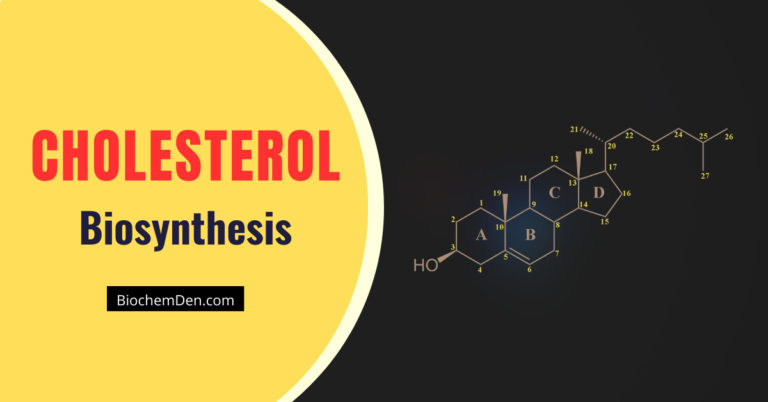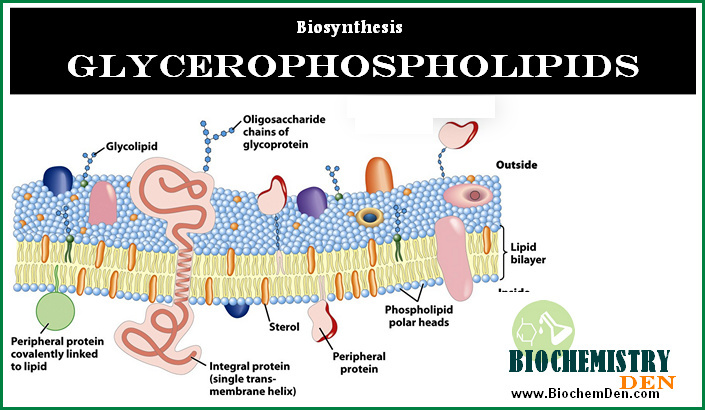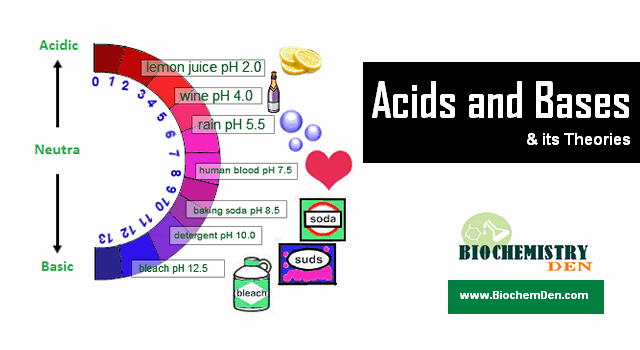Lipids are an important yet often misunderstood component of nutrition and biology. This beginner’s guide will demystify dietary fats and provide a foundation for making informed fat choices for better health.
Lipids are involved mainly in long-term energy storage. They are generally insoluble in polar substances such as water.
Secondary functions of lipids include structural components (as in the case of phospholipids, which are the major building blocks in cell membranes) and “messengers” (hormones) that play roles in communications within and between cells.

What are lipids?
Lipids are a diverse group of naturally occurring lipid molecules, including fats, oils, waxes, sterols like cholesterol, and fat-soluble vitamins. They are defined by the shared trait of being hydrophobic or “fat-loving”, meaning they do not dissolve well in water. It is because lipids contain fatty acids as their core structural component.
Lipids Definition: Lipids are a group of naturally occurring molecules that include fats, waxes, sterols, fat-soluble vitamins (such as vitamins A, D, E, and K), monoglycerides, diglycerides, triglycerides, phospholipids, and others.
The importance of lipids in biology and nutrition
Lipids play crucial roles in biology and nutrition. They serve as concentrated stores of energy in the body. The fatty acid composition of lipids also determines their structure and function. Key examples include:
- Triglycerides store excess calories in adipose tissue
- Phospholipids form cell membranes
- Cholesterol maintains membrane fluidity
Lipids also provide essential fatty acids that must come from the diet. They aid in absorbing fat-soluble vitamins A, D, E, and K.
Lipids provide an energy storage structure and enable the transport of key compounds required for survival.
Overview of what the blog post will cover
This comprehensive guide to understanding lipids will provide an overview of:
- The major categories and roles of dietary lipids
- The structure and chemistry of lipids like triglycerides and phospholipids
- Key dietary sources and intake recommendations
- How different types of fats, like saturated vs unsaturated, impact health
- The relationship between lipids and weight management
Gaining a foundation in lipid basics is the first step toward making informed dietary choices for better overall nutrition and wellness.
- Lipids comprise three fatty acids (usually) covalently bonded to 3-carbon glycerol. The fatty acids are composed of CH2 units and are hydrophobic or not water-soluble.
- A double C=C covalent bond reduces the number of hydrogens that can bond to the carbon chain, hence the term “unsaturated”.
- Fatty acids can be saturated (meaning they have as many hydrogen bonds to their carbons as possible) or unsaturated (with one or more double bonds connecting their carbons, hence fewer hydrogen).
- A fat is solid at room temperature, while oil is a liquid under the same conditions. The fatty acids in oils are mostly unsaturated, while those in fats are mostly saturated.
- Fats and oils function in long-term energy storage. Animals convert excess sugars (beyond their glycogen storage capacities) into fats.
- Most plants store excess sugars as starch, although some seeds and fruits have energy stored as oils (e.g., corn oil, peanut oil, palm oil, canola oil, and sunflower oil).
- Fats yield 9.3 kcal/g, while carbohydrates yield 3.79 kcal/g. Fats thus store six times as much energy as glycogen.
- Diets are attempts to reduce the number of fats in specialized cells known as adipose cells that accumulate in certain areas of the human body.
- By restricting the intake of carbohydrates and fats, the body must draw on its stores to make up the energy debt.
- The body responds to this by lowering its metabolic rate, often resulting in a drop in “energy level.”
- Successful diets usually involve three things: decreasing the amounts of carbohydrates and fats, exercise, and behavior modification.
- Another use of fats is as insulators and cushions. The human body naturally accumulates some fat in the “posterior” area.
Types of Lipids
Lipids can be categorized into several major classes based on their chemical structure.
Fats
Fats, also called triglycerides, are the most common dietary lipids. Triglycerides consist of a glycerol backbone bonded to three fatty acid chains that differ in length and saturation.
There are three main types of fats:
- Saturated fats: found mainly in animal fats and tropical plant oils, these contain only single bonds between the carbon atoms of the fatty acid chains. It makes saturated fats solid at room temperature. Examples include butter, lard, and coconut oil.
- Unsaturated fats contain at least one double bond in the fatty acid chains, making them liquid at room temperature. Types of unsaturated fats include:
- Monounsaturated fats like olive oil and avocados, which have one double bond
- Polyunsaturated fats like soybean, corn and fish oils, which have multiple double bonds
- Trans fats: These unhealthy fats are created through hydrogenation, which adds hydrogen atoms to vegetable oils to turn them from liquid to solid. It also creates unnatural trans-double bonds. Trans fats contribute to heart disease risk.
Phospholipids
These lipids attach a phosphate group to a diglyceride backbone, creating a hydrophilic “head” and hydrophobic fatty acid “tails”. This structure makes phospholipids ideal for forming cell membranes.
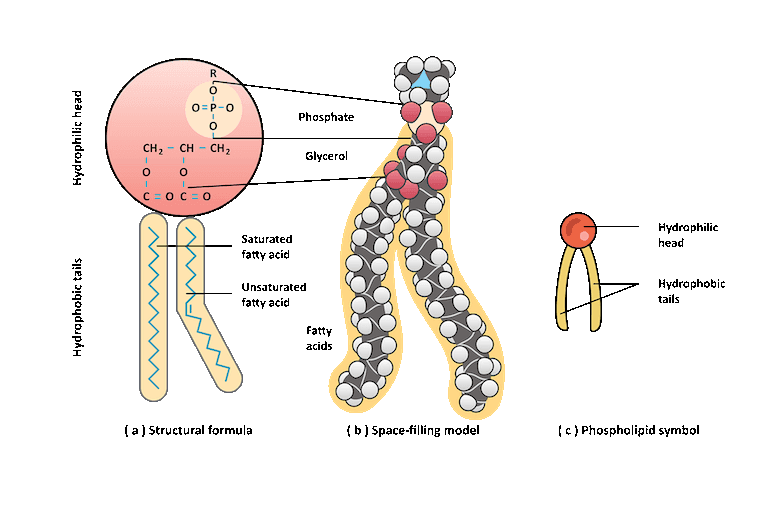
Sterols
Sterols have a four-ring steroid backbone structure. A vital example is cholesterol, which helps regulate the fluidity and permeability of cell membranes. Cholesterol also serves as a precursor for vitamin D, steroid hormones, and bile acids for fat digestion and absorption.
Structure of Lipids
The defining structural characteristic of all lipids is that they contain fatty acid chains. Let’s examine the chemical structure of the main lipid categories:
Triglycerides
Triglycerides contain a glycerol backbone bonded to three fatty acid chains:
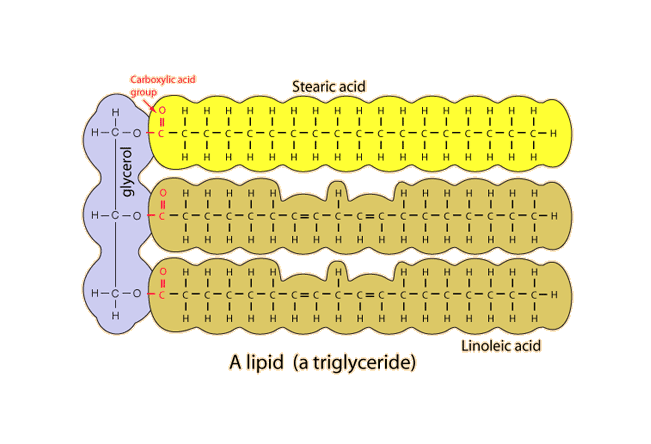
- Glycerol backbone: This is the central portion of the molecule made up of glycerol, an alcohol with three carbons, each bearing a hydroxyl group.
- Fatty acid chains: These hydrocarbon chains are attached to each of glycerol’s hydroxyl groups via ester bonds. The fatty acids differ in length, ranging from 4-28 carbons and degree of saturation.
Phospholipids
Phospholipids contain four key components:
- Phosphate head: This phosphorylated head group provides the polar, hydrophilic region of the molecule.
- Fatty acid tails: Two hydrophobic fatty acid chains attached to a glycerol backbone form the nonpolar tails. These hydrocarbon chains, again, can vary in length and saturation.
- Sterols
Cholesterol Structure
Cholesterol is a vital sterol lipid that serves critical functions in animal cell membranes and as a precursor for other biological compounds.
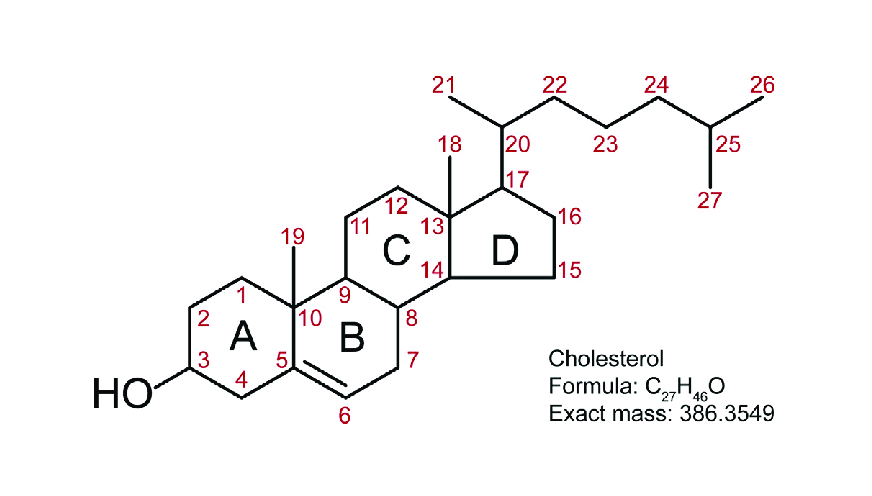
The unique chemical structure of cholesterol underlies its importance:
- Four-ring steroid backbone: The rigid four-ring cholesterol core is a steroid nucleus. This structure comprises three six-carbon rings and one five-carbon ring fused.
- Hydroxyl group: Cholesterol contains a hydroxyl (-OH) functional group attached to one of its carbon atoms. It contributes to the amphipathic nature of cholesterol, meaning it has both hydrophobic and hydrophilic regions.
- Hydrocarbon tail: A short chain is attached to the sterol ring structure. This nonpolar tail anchors cholesterol within the fatty acid core of cell membranes.
- Double bonds: There are multiple double bonds between carbon atoms in the rings, which allows some conformational flexibility.
The planar, rigid steroid structure of cholesterol allows it to pack tightly between phospholipid fatty acid tails. The hydroxyl group then provides some polarity for interaction with the membrane surface. This unique organization enables cholesterol to modulate membrane fluidity and permeability, which is critical for proper cell function.
The steroid nucleus also makes cholesterol an ideal precursor for synthesizing compounds like vitamin D, steroid hormones, and bile acids. Overall, the specialized chemical structure of cholesterol is essential to its biological roles.
Lipids’ core fatty acid components define their overall structure and function within biological systems. The fatty acids’ specific properties determine the lipid’s physical characteristics.
Functions of Lipids
Beyond their role as concentrated energy stores, lipids perform many essential functions in biological systems.
1. Energy Storage
Triglycerides in the form of fatty tissue efficiently store excess calories consumed in the diet. This stored energy can be mobilized to meet the body’s needs between meals or during fasting periods. The hydrophobic nature of triglycerides allows them to be stored in anhydrous lipid droplets without water. Lipid storage in adipose tissue provides an energy bank for the body.
2. Structural Role in Cell Membranes
The amphipathic nature of phospholipids makes them ideal building blocks for cell membranes. The hydrophilic phosphate heads orient towards the membrane’s exterior, while the hydrophobic fatty acid tails face inward. It forms a stable phospholipid bilayer structure that defines cell boundaries and controls material transport in and out of the cell. Cell membrane structure relies on phospholipids.
Cholesterol also assists with membrane structure and function. The ability of cholesterol to pack closely between phospholipids while allowing fluid movement modulates membrane fluidity and permeability. The presence of cholesterol affects the fatty acid composition and properties of the membrane.
3. Insulation and Cushioning
Padding of subcutaneous fat composed of triglycerides helps insulate the body against heat loss. Lipids also protect and cushion vital organs like the kidneys from damage.
4. Essential Fatty Acids
Certain polyunsaturated fatty acids, like the omega-3 and omega-6 families, cannot be synthesized by the human body. These essential fatty acids must be obtained through the diet and are critical for blood clotting, inflammation, immune response, and development.
5. Absorption of Fat-Soluble Vitamins
Dietary lipids are crucial for absorbing the fat-soluble vitamins A, D, E and K. Without adequate fat intake, these vitamins would pass through the digestive system unabsorbed. Lipids envelop the vitamins into chylomicrons, enabling transport.
6. Blood cholesterol lowering:
- Chocolates and beef, especially the latter, were believed to cause many heart diseases as they are rich in saturated fatty acids, which boost cholesterol levels in the blood and clog the arterial passage.
- However, research conducted at the University of Texas by Scott Grundy and Andrea Bonanomi (1988) suggests that at least one saturated fatty acid, stearic acid, a major component of cocoa butter and beef fat, does not raise blood cholesterol.
- The researchers randomly placed 11 men on three cholesterol-poor liquid diets for three weeks each.
- One formula was rich in palmitic acid, a known cholesterol booster; the second in oleic acid; and the third in stearic acid.
- Compared with the diet rich in palmitic acid, blood cholesterol levels were 14% lower in subjects on the stearic acid diet and 10% lower in those on the oleic acid diet.
7. Antibiotic agent
Squalamine, the shark’s blood steroid, is an antibiotic and antifungal agent of intense activity. It explains why sharks rarely contract infections and rarely get cancer.
In summary, lipids serve diverse roles, from concentrated energy storage to forming cell structures, providing protective padding, and aiding the absorption of key compounds required for life. Appreciating the varied biological functions of lipids in the body provides insight into their importance for health.
Dietary Sources of Lipids
Understanding where lipids are found in the diet is important for making informed food choices.
a. Common Dietary Sources
Lipids are present in both plant and animal foods. Major dietary sources of lipids include:
- Oils: olive, canola, soybean, corn, sunflower, safflower
- Tree nuts and seeds: almonds, walnuts, and sunflower seeds
- Avocados
- Fatty fish: salmon, mackerel, tuna
- Meat and poultry
- Dairy products: milk, cheese, butter, cream
- Baked goods and processed foods
- Fried foods
- Eggs
These foods provide lipids in triglycerides, phospholipids, and cholesterol. Oils and nuts contain mostly unsaturated fat triglycerides, while meat and dairy provide significant saturated fats.
2. Recommended Intake
Health organizations like the American Heart Association provide general recommendations for daily dietary lipid intake:
- 20-35% of total calories from fats
- Less than 10% of calories from saturated fats
- Up to 10% of calories from polyunsaturated fats
- Up to 15% of calories from monounsaturated fats
The emphasis should be on reducing the intake of saturated fats and replacing them with more heart-healthy mono- and polyunsaturated fatty acid sources.
3. Food Selection
When selecting food sources of lipids, aim for more unsaturated varieties by choosing:
- Plant oils like olive and canola oil
- Nuts, seeds and avocados
- Fatty fish high in omega-3 fatty acids
- Meanwhile, limit intake of saturated fats from:
- Butter, cheese and fatty meat
- Fried and processed foods
- Baked goods made with trans or hydrogenated fats
Choosing food sources wisely helps optimize fatty acid composition and lipid-rich intake for good health.
4. Supplements
Some people may require omega-3 fatty acid supplements from fish, krill or algal oils to obtain adequate amounts, especially vegetarians/vegans. Vitamin E and occasionally vitamin D supplementation may also be prudent for those lacking sufficient dietary fat intake.
A balanced diet should aim to obtain essential lipids from varied whole food sources like nuts, seeds, fish and plant oils over processed animal fats or supplements.
Health Implications of Dietary Lipids
While lipids are an essential macronutrient, an imbalance in dietary lipid intake can negatively impact health.
1. Benefits of Healthy Lipids
Consuming certain lipids in moderation provides benefits:
- Monounsaturated and polyunsaturated fats help lower LDL cholesterol and heart disease risk when they replace saturated fat intake.
- Omega-3 fatty acids support heart health, brain function, fetal development and more.
- Adequate cholesterol is needed to produce steroid hormones, vitamin D, bile acids, and cell membranes.
2. Risks of Unhealthy Lipids
However, overconsumption of certain lipids poses risks:
- Saturated fats raise total and LDL cholesterol levels, contributing to atherosclerosis and heart disease.
- Trans fats also raise LDL and lower HDL cholesterol, increasing the risk of heart attack and stroke.
- Excess omega-6 fatty acids promote inflammation when not balanced by omega-3s.
3. Cholesterol and Heart Disease
Dietary cholesterol has a relatively modest impact on blood cholesterol levels compared to saturated fats. However, total cholesterol levels above 200 mg/dL correlate with an increased risk of heart disease. Lifestyle changes and medication can help manage healthy cholesterol levels.
4. Omega-3s and Omega-6s
Consuming omega-3 fatty acids from fish, nuts, and seeds helps balance pro-inflammatory omega-6 fats from vegetable oils. A dietary ratio closer to 2:1 or 4:1 omega-6 to omega-3 fats is optimal, compared to the typical Western ratio of 10-20:1.
5. Trans Fats
Artificial trans fats produced by hydrogenation provide no health benefits. The World Health Organization recommends limiting trans fat intake to less than 1% of total calories. Many countries have enacted bans on trans fat use in food manufacturing.
Overall, lipid quality trumps just quantity regarding impacts on heart health. Limiting saturated and trans fats while including omega-3s, monounsaturates and moderated cholesterol intake as part of a balanced diet is the healthiest approach.
Lipids and Weight Management
Dietary fats are often avoided in weight loss diets, but lipids can play an important role in body weight regulation when consumed wisely.
1. Total Calorie Balance
Consuming excess calories, whether carbs, protein or fat, can lead to weight gain over time. The focus should be on maintaining an appropriate calorie balance based on your energy needs.
2. Effects of Different Fats
Based on some research, diets higher in monounsaturated fats may promote greater fat loss compared to low-fat, high-carb diets.
Including more omega-3 fats from fish and nuts may also boost fat burning and reduction of body fat versus diets high in saturated fat or omega-6s.
3. Ketogenic Diets
Very low-carb, high-fat ketogenic diets can promote short-term weight loss through ketosis. However, these diets may lack long-term sustainability for weight management due to restrictions.
4. Physical Activity
Regular exercise is key for long-term weight management. It helps build calorie-burning muscle mass and increases daily energy expenditure.
5. Appetite Regulation
Dietary fats help regulate appetite hormones and reduce spikes and crashes in blood sugar that spark hunger.
6. Diet Quality
Emphasizing overall diet quality with minimally processed foods, plenty of vegetables, and appropriate portions aids in lasting weight management.
For optimal and sustainable weight regulation, the focus should be on diet quality, calorie balance, and an active lifestyle rather than drastic fat restriction. Moderation and variety of lipid intake paired with exercise provide the best approach.
Frequently Asked Questions (FAQs)
What are the main types of lipids?
The major lipids categories are fats (triglycerides), phospholipids, and sterols like cholesterol.
How do lipids differ from carbohydrates?
Lipids contain fatty acids and are hydrophobic, while carbs contain sugars and are hydrophilic. Lipids serve as concentrated energy stores, while carbs provide fast energy.
Where are lipids stored in the body?
Triglycerides are stored in adipose tissue or body fat. Cholesterol is stored in cell membranes. The liver helps metabolize lipids.
What are examples of unsaturated fats?
Monounsaturated fats like olive oil and polyunsaturated fats like sunflower oil and fatty fish contain double bonds, making them unsaturated.
How can I improve my dietary fat intake?
Focus on healthy unsaturated fats from plant sources and fish while limiting saturated fats from red meats, dairy, and fried foods. Moderation is key.
Conclusion
In summary, this guide has provided a comprehensive overview of the fundamentals of lipids, from their structure and types to biological functions, dietary sources, and health implications. Key takeaways include:
- Lipids like triglycerides, phospholipids and sterols share the unifying trait of containing hydrophobic fatty acids as their core structural component.
- Triglycerides serve as concentrated energy storage in adipose tissue, while phospholipids form the basis of cell membrane structure.
- A heart-healthy dietary pattern emphasizes unsaturated fats from plant oils, nuts, seeds and fatty fish over saturated fats predominant in many animal products.
- Excess calorie consumption can lead to weight gain regardless of macronutrient source. The total calorie intake matters most for weight management, along with diet quality, exercise and appetite regulation.
- Incorporating more omega-3 fatty acids relative to omega-6s provides unique health and anti-inflammatory benefits.
- Trans fats produced industrially via hydrogenation provide no nutritional advantage and should be avoided in the diet.
- Adhering to dietary recommendations for healthy lipid intake as part of a nutritious, balanced diet can help reduce the risk of chronic illnesses like heart disease, diabetes and cognitive decline.
With this knowledge about the structure, function, sources and health effects of the diverse lipids in nature, you are now equipped to make informed decisions about optimizing your dietary fat intake. Referencing this guide to lipid basics is the first step to translating the science into actionable and sustainable dietary changes for better overall wellness.
Discover more from Biochemistry Den
Subscribe to get the latest posts sent to your email.

